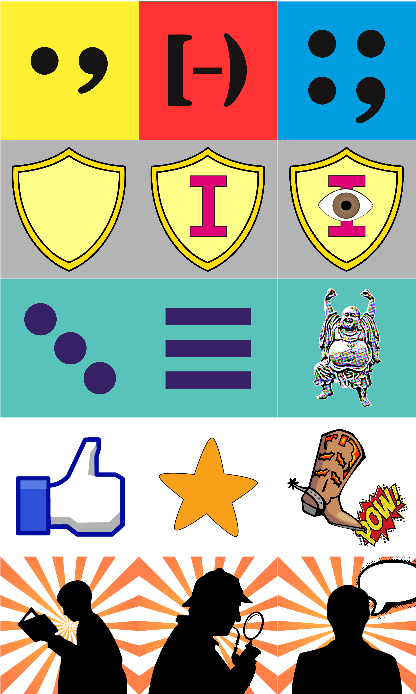Every couple of months a new word or two in my very mild accent proves indecipherable to locals. There has been a lot of ‘badgers?’ lately, as I talk about this project, but I cracked up when ‘breeders’ got misheard as ‘burritos’.
Anyway.
I mentioned on Twitter a couple of weeks ago that my students in RHE306: Rhetoric and Writing class (the introductory composition course here at the University of Texas) had developed a badging system for various aspects of their writing, including, charmingly, a cowboy boot to symbolise ‘kickass’ conclusion-writing skillz. It took me awhile to carve out the time to turn their crayon sketches into something I can actually get printed onto tiny wee stickers*, but here’s a low-res sneak peek.
The badges project began when my students requested gold stars for huge successes on their papers. Fine by me (despite the obvious superiority of scratch-n-sniff stickers over gold stars), but as we continued to talk about their goals and the kind of feedback they wanted, someone cracked a joke about wanting ‘Boy Scout badges’ for writing — and the whole class perked up and started throwing ideas around. Lots of noise and creativity. It was exciting!
We agreed that we’d come in on Wednesday, the next class day, with each person bringing an idea for a badge and an argument for why that idea matters to the course. They go home to finish up their first major papers, due on that Wednesday, and I go home and immediately get caught up in reading about other people’s applications of badges in rhet/comp.
And so Wednesday rolls around, and I walk into class and collect the papers, and then say, ‘So. Badges. Tell me what you got.’ And my students say, ‘Wait? We’re really doing this? I thought it was a joke.’
But we pressed through. The students brainstormed a list of about a dozen potential major skills, debating — heatedly at times — the relative merits and pitfalls of each one. They agreed on a ‘Novice’, ‘Intermediate’, ‘Master’ structure and voted on a top-5 list to actually implement: Punctuation; Introductions; Transitions; Conclusions; Argument. (That’s the order they appear in above.) The students then self-selected into five task forces (actually four; Team Transitions was just me) to come up with criteria for each level and an assessment/awarding scheme, as well as a design for the badge.
Most of the teams came up with straightforward progressive models for moving from Novice to Master levels, using examples of techniques that get more sophisticated as you go along. Team Conclusions went with a crowdpleasing description, ‘A kickass conclusion: you’ll know it when you see it’, for their Master level; I described Transition Mastery as ‘achieving zen flow’ (hence happy Buddha); Team Punctuation had a long argument about whether parentheses or semi-colons are harder to use (semi-colons won and their Intermediate badge is, to my eyes, a happy Cylon emoticon). The Arguments group wound up going in a different direction; they chose to award badges for successful demonstration of the overall goals of the three major papers in the course — research, analysis and argument. They also ran out of time to draw up a badge, so I’m going to take all the credit for how cool that bottom row looks.
As well as being (mostly) student-designed, these badges will be student-awarded — every paper in the class is peer-reviewed, so students will be nominating others to receive the badges during that process. I was put in charge of making final determinations (‘Yes, that’s exactly how you use semi-colons’), but I plan to be pretty hands-off.
Regardless of the success of the actual implementation once the stickers arrive, though, I’m pleased by my students’ engagement with the course goals, and ability to set achievable but challenging interim and final goals. Everyone in the group bought in (once we got past the isn’t-this-a-joke stage) and found something to contribute; they also found ways to adapt the class-wide structure to meet the goals of their particular skillset. And who knew that freshmen in a compulsory class could get into a heated argument over the relative sophistication of two forms of punctuation? Love. This exercise will be staying in the toolbox.
* Tiny wee stickers was the result of a class vote. It was a close-run thing as to whether they’d be 1in pins — I was in favour of this, since I loved the idea of students wandering around campus saying things like, ‘Oh, yeah, I got this in my Rhetoric class because I’ve mastered the use of semi-colons. They separate two independent but closely connected clauses, y’know.’ Maybe next year.
